These TS 6th Class Science Important Questions 12th Lesson Simple Electric Circuits will help the students to improve their time and approach.
TS 6th Class Science Important Questions 12th Lesson Simple Electric Circuits
Question 1.
Why the position of cells affects the working of a torch-light?
Answer:
If the cells are wrongly placed in their positions, the circuit does not complete. Electricit does not flow in the circuit. Then the torch light did not work.
![]()
Question 2.
Can you describe a torch cell?
Answer:
- The cell consists of a cylindrical metal can. It is heavy in C weight because it is filled with some chemicals.

- There is a carbon rod in its centre. This carbon rod protrudes on one end of the can.
- It is covered with a small metal cap. This is the positive terminal of the other side.
- This metal disc is the negative terminal of the cell. The entire can is sealed.
![]()
Question 3.
What does a torch light bulb contain? How does it differ from an electric bulb?
Answer:
Torch bulb : A torch bulb consists of a glass chamber fixed on a metal hase.
Two metal wires are firmly fixed. One wire is attached to the metal cap. The other wire is attached base at the centre of the metal cap. These wires act as two terminals. These two terminals do not touch each other.
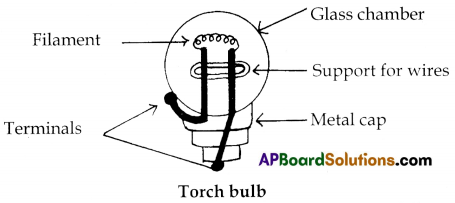
Electric bulb : The arrangement in an electric bulb is different. In this bulb,the two metal wires are attached to the two teminals at the bottom of the metal cap. The bulb contains a filament made of tungsten metal. It is a thin spring-like wire. It is attached to the two metal wires inside the glass chamber.
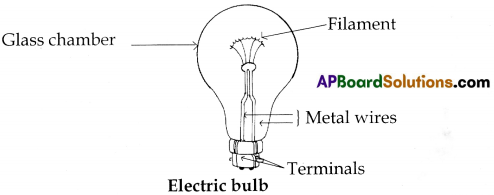
Question 4.
Why do bulbs have two terminals?
Answer:
- In an electric bulb, there are two metal wires.
- One end of each wire, forms a terminal. Thus, there will be two terminals.
- Current enters or leaves the wires in the bulb through these terminals.
- Current enters the bulb through one of these terminals and leaves the bulb through the other terminal so there are two terminals in a bulb.
![]()
Question 5.
How does a bulb glow with the help of a cell?
Answer:
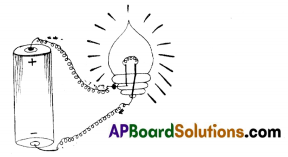
- Both the electric cell and the bulb have two terminals each.
- One terminal of the cell is connected to a terminal of the bulb by a conducting wire.
- The other terminal of the cells is connected to the other terminal of the bulb by mother conducting wire. Then the bulb glows.
Question 6.
Name the different parts of a torch-light.
Answer:
The parts of a torch-light are: A hollow cylindrical barrel, cells, bulb, reflector, glass cover, switch and a metal spring.
Question 7.
What does a torch consist ?
Answer:
Torch consists a hollow cylindrical barrel. Cells are fitted in it. At one end of it there is a lid with screw. The lid can be unscrewed and removed, if required.
Question 8.
What makes the torch bulb to glow?
Answer:
- The open-end of the barrel is closed with the lid and the switch is put ON.
- Circuit completes and current flows in the circuit.
- Then the bulb glows.
Question 9.
What is the material of the filament in a ‘filament bulb’?
Answer:
Tungsten
Question 10.
What material do you find in electric wires?
Answer:
Metal (usually copper)
Question 11.
Can electric current pass through a sheet of thermocole?
Answer:
No.
Question 12.
Can we use jute string in place of metal wire, to make a circuit?
Answer:
No.
![]()
Question 13.
What are the materials required for producing electric circuits to make the bulb glow ?
Answer:
A bulb, a wire, power (cell or electricity) switch, drawing pins, etc are required for producing electric circuits to make the bulb glow.
Question 14.
What are conductors and insulators? Give two examples. (or)
What are conductors and insulators? Separate the following substances as conductors and insulators.
[Iron nail, piece of paper, piece of metal, bangle, hairpin, eraser]
Answer:
Conductors : Substances which allow electric current to flow through them are called conductors.
Insulators : Substances which do not allow electric current to flow through them are called insulators.
| Conductors | Insulators |
| Iron nail | Piece of paper |
| Piece of metal | Bangle |
| Hair pin | Eraser |
Question 15.
How are the bulbs in our houses connected?
Answer:
The electric supply vires in our house are called live and neutral. They are connected to the two terminals of the bulb through a switch. The switch is used to close or open the electric circuit.
Question 16.
What is the use of a torch-light?
Answer:
Torch-light is used as a source of light.
Question 17.
Why don’t we use electric wires without removing the plastic covering?
Answer:
Plastic is a non-conductor of electricity. So it should be removed and then the metal wire connected.
Question 18.
Why are we advised to wear rubber chappals while working with electricity?
Answer:
Rubber works as a non-conductor of electricity. So we are advised to wear rubber chappals while working with electricity.
Question 19.
What happens if the two terminals of a cell are connected with a single wire?
Answer:
The cell gets discharged soon. Thus electrical energy gets wasted.
![]()
Question 20.
Can you find why the bulb glows only when cells are placed in particular position?
Answer:
Yes. For the electricity to pass, opposite ends of the two cells should be in direct contact with each other. Then only the circuit completes.
Question 21.
Write the material required, procedure and observations to prepare a simple electric circuit.
Answer:
Aim : To prepare an electric circuit with available material.
Required material : Insulated wires, battery or cell, bulb, switch (drawing pins) wooden plank or thermacol sheet etc.
Procedure:
- Three pieces of plastic covered vires are taken.
- At least two centimeters of plastic covering is removed at both ends of the wire pieces.
- Now one end of two tyres are attached to a bulb and other end is attached to a cell and a switch.
- Switch is prepared with the safety pin at A and B on wooden plank.
- The third vire piece is attached between the cell and switch point B.
- It should be seen that the safety pin is attached at point B.
- It should he done in such a way that one end of the pin is in contact with B and the other end is left free.
- Now both ends A and B are connected with safety pin.
Observation : When safety pin is connected between A and B the switch is ON. Then the bulb glows.
When safety pin is disconnected from A the switch is OFF. Then the bulb stops glowing.
Question 22.
The wires are connected in different forms as shown in figures A, B, C, D, E and F. In each case, record whether the bulb glows or not. Give reason.
Answer:
figures
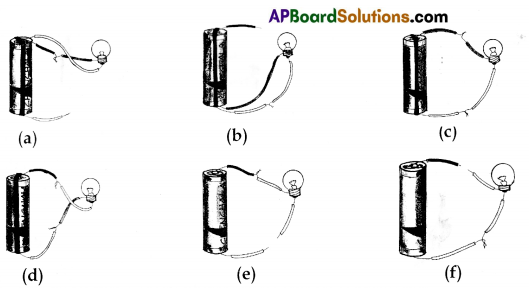

![]()
Question 23.
An open circuit is given. Different objects are given. Insert the objects one by one in the gap between the open terminals A and B. With each insertion, check whether the bulb glows or not. Record your observations in the table provided.
Answer:
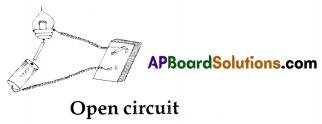
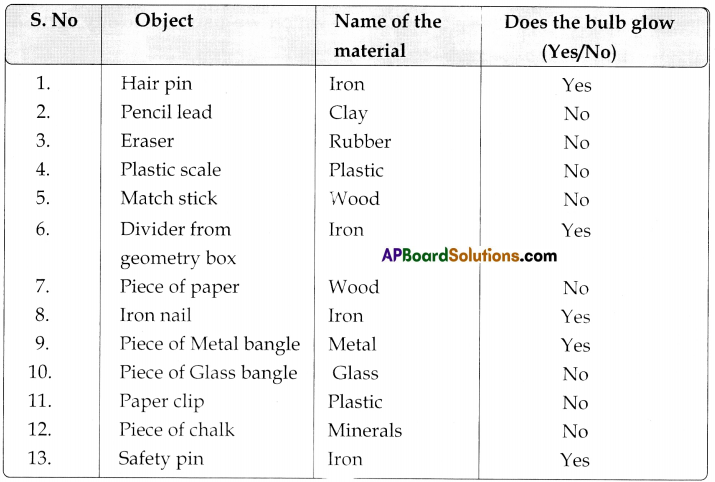
Question 24.
Draw a sketch of torch-light.
Answer:
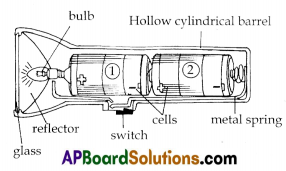
Question 25.
Arrange the two cells in a torch in as many ways as you can. In which cases does the bulb glow and in which cases it doesn’t?
Answer:
The two cells in a torch can be arranged in the following four ways.

Bulb glows in cases : A and D.
Bulb does not glow in cases: B and C.
Question 26.
List out the daily activities in which we use electricity. Give two suggestions to save electricity.
Answer:
The daily activities in which we use electricity.
- Getting air through fans and ACs.
- Storing the food material through refrigerators.
- Getting water from wells through motar pump sets.
- Using electricity for travelling and transportation through vehicles, electric trains etc.
- Grinding the food material with the help of mixers and grinders.
- Ironing the shirts.
![]()
Suggestions to save electricity:
- Switch off the fan and lights whenever you leave the home.
- Check up the water taps and keep them in good condition to avoid wastage of water. So that the electricity used for water supply will he saved.
- Everyone should see that keeping electrical circuits such as switches, plugs, bulbs etc., in good condition.
- It is very good to use LED bulbs instead of using tungsten filament candle bulbs and tube lights.
Question 27.
a. Make an Electric Circuit with the following picture.

Answer:
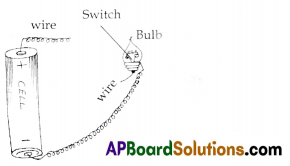
b. When did the bulb not glow in the circuit?
Answer:
When the circuit broke, the bulb did not glow.